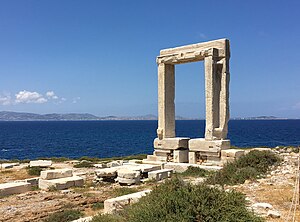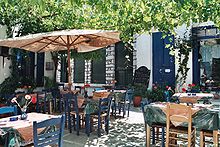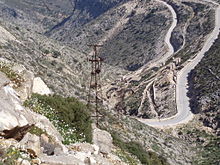Naxos
| Naxos (Νάξος) | ||
|---|---|---|
| Naxos, Portara | ||
| Waters | Mediterranean Sea | |
| Archipelago | Cyclades | |
| Geographical location | 37 ° 3 ' N , 25 ° 28' E | |
|
|
||
| length | 32.5 km | |
| width | 21.7 km | |
| surface | 389.43 km² | |
| Highest elevation | Zas 1001 m |
|
| Residents | 17,930 (2011) 46 inhabitants / km² |
|
| main place | Naxos (Chora) | |
Naxos ( Greek Νάξος ( f. Sg. ), Also Náxia ) is a Greek island in the Aegean Sea . With an area of 389.43 km², it is the largest island in the Cyclades and is only separated from the island of Paros by a narrow strait. Naxos has steep banks in the east, flatter land to the west and is criss-crossed from north to south by a granite mountain that rises up to 1000 m in Mount Zas (also: Oxia) .
According to the last census in 2011, the island has 17,930 inhabitants (with the number of residents actually fluctuating depending on the season). The main town and port is called Naxos and, like the main towns on almost all islands, is called Chora (Greek Χώρα). The city is the central port of the island (for ferry services, fishing and recreational shipping) and the seat of the Greek Orthodox Bishop of the Diocese of Naxos-Paros .
geology
In the northwest of Naxos lies Migmatit ; Marble is found in the south and east of the island. In between are mica slate and gneiss, and in the west there are granodiorites and conglomerates . Marble is the most extensively quarried stone that is mainly quarried at Kinidaros today. There are ancient marble quarries at Apollonas and Melanes, for example, and emery is mined in the area of Aperathos and Koronos .
history
Mythology and Prehistory
The prehistoric inhabitants of the island are, according to Thucydides and Herodotus Karer have been that from the Cretan King Minos , according to another version of Ionians and Dorians were sold to Asia Minor. According to legend, Theseus is said to have left the Cretan king's daughter Ariadne here after his victory over the Minotaur on his way back from Crete to Athens , whose cultic veneration as the vegetation goddess of ancient Naxos is attested.
Archaeological research has shown that Naxos was populated as early as the late Neolithic and Bronze Age Cycladic cultures. Sites on the island gave its name to the Grotta Pelos culture , which began in the late Neolithic (around the middle of the 4th millennium BC) and which continued into the early Cycladic (up to around 2650 BC).
Antiquity
The island, which was ruled as a unified state throughout its history, already flourished in the late Geometric and early Archaic times : Naxians founded 735 BC. The first Greek colony in Sicily ( Naxos , today: Giardini-Naxos ). The worship of Dionysus as the central god is attested for the archaic period , and places of worship for Zeus , Apollon and Demeter are also documented. In the thirties of the 6th century BC The now defeated small state of Naxos first got into the continental conflict between Athens and Sparta when Peisistratos of Athens violently installed Lygdamis , the leader of the oligarchic party on Naxos, as a tyrant over the island. A Spartan expedition ended in 524 BC. His rule. The construction of a monumental Dionysus temple on an island in front of the main port was abandoned. Naxos finally lost its importance after the conquest and destruction by the Persians in 490 BC. Chr.
After the Naxian ships had passed over to the Greeks in the Battle of Salamis and had won freedom from Persian supremacy, the island became a member of the Attic League , but fell in 467 BC. After the forced submission to Athens, it finally lost its autonomy and shared the fate of the islands under the rule of Philip II of Macedonia, his son Alexander , the Diadochi and the Romans.
The intellectual and cultural role of Naxos in ancient Greece is of little importance. The Naxian sculpture schools of the 7th and 6th centuries BC are worth mentioning. Chr.
middle Ages
see also: Duchy of Archipelagos

Since 395 Naxos belonged to the Eastern Roman Empire. In the Middle Ages the island was named Naxia . After the Crusaders had conquered Constantinople in 1204 and the Byzantine Empire collapsed, Naxos also came under the rule of the Latins . The Venetian Marco Sanudo conquered the island in 1207 and received it and the other islands of the Cyclades from the Latin titular emperor Ostroms Heinrich von Hainault in 1210 as a hereditary feudal duchy. The conqueror was made Duke of the Archipelagos and Naxos became the seat of the Duchy.
Sanudo distributed the conquered land among the officers of his fleet, who built fortified residences on approx. 50 fiefs and established feudal rule of Western European character in the Aegean for centuries . A twelve-tower castle complex was built over the ancient remains on the town hill of Naxos, enclosing the ducal palace and the town houses of the feudal men. In the middle of the castle, a bishopric of the Roman Catholic Church ( Archdiocese of Naxos, Andros, Tinos and Mykonos ) was built, which is still part of the island's population today (especially on Syros and Tinos ).
When the house of Sanudo became extinct in 1362 in the male line, the husband of the daughter of the last duke, Giovanni dalle Carceri, Lord of Negroponte (d. I. Euboea ) received the Duchy of Naxos. As the last Latin dukes, the Crispi ruled from 1383 to 1564 .
Modern times
As early as 1537, the island came under Ottoman rule after it was conquered by Chaireddin Barbarossa's fleet . As the first successor to the Venetian dukes, Sultan Selim II the drunkard transferred control of Naxos to the Marran Iussuf Nassí in 1566 . Under Nassí, who never set foot on the island until his death in 1579, as subsequently until the Greek struggle for freedom from 1821, the island was under alternating administration of tributaries of the Sublime Porte , who belonged to the Italian and French aristocracy and the urban patriciate of Constantinople Greeks.
During the Greek War of Independence from 1821 there was no fighting on the island, but Naxos experienced an influx of refugees from the fighting areas of the mainland and the islands. With the beginning of the reign of Ioannis Kapodistrias (1827), Naxos became part of the initially autonomous, from 1829 independent Greece and shared its fate. During the Second World War, Naxos was occupied by up to 2,000 Italian soldiers from 1941 until the fall of Mussolini in 1943, and from October 1943 by only 70 Germans who were captured in October 1944 in preparation for their withdrawal after three days of fighting.
Administrative division
After the founding of the state of Greece , the island of Naxos was divided into two districts between 1834 and 1912. The communities Naxos and Vivlos with the main town Naxos formed one district. The second district consisted of the communities Apiranthos, Koronis and Tragea with the main town Tragea. After a further 10 municipalities were created in 1912 through division of areas, the number increased from 15 to 21 rural municipalities by 1951 through minor area corrections, and the city of Naxos received the status of a municipality. Through the implementation of the territorial reform according to the Kapodistrias program in 1997, the island of Naxos was subdivided into the two municipalities of Naxos and Drymalia with a total of 22 municipal districts. In the course of the Greek administrative reform in 2010 , they were merged with the former island communities of the Little Cyclades to form the municipality of Naxos and Little Cyclades and were given the status of municipal districts. The municipality with the largest area of Drymalia is divided into one municipality and ten local communities, the most populous municipality of Naxos is divided into two municipalities and nine local communities.
| Parish | Greek name | code | Area (km²) | 2001 residents | Residents 2011 | City districts / local communities (Δημοτική / Τοπική Κοινότητα) |
location |
|---|---|---|---|---|---|---|---|
| Naxos | Δημοτική Ενότητα Νάξου | 670201 | 126,957 | 12,089 | 12,726 | Naxos , Agios Arsenios, Vivlos, Galanado, Galini, Glinado, Engares, Kinidaros , Melanes , Potamias, Sangri | |
| Drymalia | Δημοτική Ενότητα Δρυμαλίας | 670203 | 302.828 | 6,099 | 5,204 | Aperathos , Filoti, Damarionas, Danakos, Keramoti, Koronis, Koronos, Mesi, Moni, Skado, Chalki | |
| total | 6702 | 429.785 | 18,188 | 17,930 | |||
economy
The island is well watered and particularly fertile in the lower parts near the northwest coast and in a central basin inland, but also in the terraced gardens of numerous mountain villages. The agricultural activity is focused on fruit and vegetable growing, wine, oil and olive production , grain cultivation (especially barley as fodder), cattle breeding and dairy products ( cheese , yogurt ).
Naxos marble is mined industrially ; the mining of emery , which was the most important industry on the island until the middle of the 20th century, was stopped. Emery has been extracted from underground mining in small tunnels since ancient times. It was and is used as an abrasive . For decades, the Naxos-Union company in Frankfurt had had the exclusive right to sell Naxos emery on mainland Europe for decades. As a result, Naxos-Union not only manufactured abrasives, but also developed and produced the first stone grinding machines since 1880 . With the introduction of electrical corundum and silicon carbide as substitutes, natural emery has lost its importance for the manufacture of grinding tools since the beginning of the 20th century.
Tourism has been of central importance to the Naxian economy since the 1980s. The built-up urban area alone has almost doubled since then, and numerous holiday homes have been built by Greeks and foreigners in the coastal areas. The beach section Agia Ana - Plaka with its dunes, which was unique until a few years ago, is now heavily used for tourism, there is hardly a place on this beach that is not occupied by a hotel with sun loungers and parasols that are subject to a fee. The island has only been left free of extensive overbuilding by large hotel complexes, despite kilometers of beaches in front of partially fragmented dunes, especially along the west coast. Massive influx is prevented by the lack of an international airport, but parts of the island's tourism industry have long been calling for the expansion of the airport , which only serves domestic traffic . The local climate, which is characterized by strong winds and rather cool temperatures on 240 days a year, not least in the summer months, may also be a hindrance to use as a mass destination. In addition, access to the sea is severely hindered in some places by jagged stone slabs overgrown with algae.
Securing the ferry port open to the sea, next to Paros the central distributor of the eastern Cyclades, is a goal that is opposed to the natural condition of the port bay.
Attractions
- Castle town ( Kastro )
The island's capital is dominated by the castle complex built by the Venetians over the 30 m high city hill. Of the former 12 defensive towers, the Glezos Tower is the only one that stands upright. The neighboring Trani Gate , one of what was once three entrances to the castle, has been preserved almost intact. In the interior of the castle town are the residences of the Catholic aristocracy, one of the houses is open as a museum of Venetian living culture . Opposite the Catholic Episcopal Church is the Archaeological Museum with finds from the island on the central square .

- Citizen town
Down to sea level, the castle hill is surrounded by the almost unchanged middle-class town with its narrow medieval street structure, especially in the districts of Boúrgos and Agorá . Under the orthodox bishop's church in the Grótta district, excavations of building remains from the early settlement period around 1600 BC are in the Grotta Museum . To visit.
On the former island of Palátia off the port, the only relic of the unfinished Temple of Apollo of Lygdamis is the mighty gate of Opisthodom from the late 6th century BC. BC, the Portara. The marble temple portal measures 5.95 m in height and 3.65 m in width.
- Residential towers
Over the entire island, strategically distributed, there are numerous castle-like Venetian buildings (Pyrgi, singular Pyrgos = tower) of the late Middle Ages, built both as country seats of the nobility within each assigned fiefdom and as fortresses against attacks on the island.
- Kouroi
Three ancient, unfinished monolithic colossal statues, so-called youths ( kouroi ), hewn from the rough stone, are still lying in quarries from the archaic period . The statues date from the 7th or 6th century BC. And were intended for installation in shrines. They probably represent the gods Apollon or Dionysus . The Kouros of Flerio near Melanes , which is located in a village garden, reaches a size of 5.5 m and a second is in a quarry near the place. The Kouros of Apollonas , also called Apollon , which is stored openly at a low height above the village of Apollonas , measures 10.7 m. It is not known why the kouroi were not completed. Research suggests that this kouros was too heavy to transport. The thesis that the client stopped their payments or that the work was canceled because the marble blocks turned out to be faulty during processing or broke due to lack of care during processing are not substantiated. Both of Flerio's kouroi broke off at their weakest point during transport, at the transition from the legs to the feet. The broken stone feet were found near a kouros.
- Byzantine churches
There are more than 150 early Christian and Byzantine churches on Naxos. About half of them have frescoes or fresco remains, which is why Naxos is sometimes referred to as the "Byzantine Pinacoteca of the Aegean". The unique ensemble covers all epochs from the 6th to the 13th century. The representations in the Panagia Drosiani near Moni from the 6th century are among the most important in Greece. In the dome, Christ is depicted as both a young and an older man. Also significant are the testimonies from the iconoclasm period , when images of saints were replaced by geometric patterns, animal and plant motifs. The churches are spread all over the island, with a focus on Chalkí and Sangrí. Many of them are in bad shape. Some are just ruins.
- Industrial monuments
The mountain heights above the east coast are interspersed with abandoned emery mines. From there, preserved cable car lines lead down to the small port of Moutsoúna. Although the systems were decommissioned in 1941, the filled containers are still hanging on the ropes. In the meantime, however, there is a risk of collapse. On the road to Lionas, an attempt was made a few years ago to use EU funds to convert a facility into a kind of museum. Apart from a few half-finished buildings and newly laid out paths, there is hardly anything left of this project, only the construction site sign in a rock cut on the ground indicates this.
- Menhir and city of the dead Tsikalario from the Geometric period (approx. 1000–700 BC).
literature
- Dirk Schönrock: Naxos. M. Müller, Erlangen, 6th edition 2015, ISBN 978-3-89953-998-1 .
- Ernst Curtius : Naxos. A lecture was given in the scientific associations in Berlin in 1846. Digitized , newly published by Martin Biastoch , Göttingen 2012.
- Georgios M. Melissinos: Naxos. Naxos 1968 (Greek); Local history survey, rich collection of material on Naxos, not always reliable.
- Luca Giuliani: The Colossus of the Naxians . In: Luca Giuliani (ed.): Masterpieces of ancient art . CH Beck, Munich 2005, pp. 13-27, ISBN 3-406-53094-X .
- Christian Ucke: Hiking on Naxos. Ed. Graf, 2nd edition Munich 2010, ISBN 978-3-9808802-8-2 (detailed maps, GPS data, photos and special information on landscape, fauna, flora, climate, geology and history).
- M. Chatzidakis: Byzantine Art In Greece - Naxos. “Melissa” 1989, Athens
- Γεώργιος Στυλ. Μαστορόπουλος, Νάξος - Το άλλο κάλλος, Ελληνικές Ομοιογραφικές Εκδοσεις (Greek and English)
- Naxos. Map 1: 40,000. Anavasi-Verlag, Athens 2015. ISBN 978-960-8195-54-7 (folded, with GPS grid, very accurate and detailed map of Naxos).
Web links
- Geological map of Naxos
- Mark Cartwright: Naxos , in: Ancient History Encyclopedia
Individual evidence
- ↑ Νάξος - Naxos, 1: 40,000 (Map 311) . ΣΚΑΪ, Nea Ionia , Athens 2009.
- ↑ Naxos, Ministry of Merchant Navy, Aegean and Island Policy, Greek [1]
- ↑ a b Results of the 2011 census, Greek Statistical Office (ΕΛ.ΣΤΑΤ) ( Memento from June 27, 2015 in the Internet Archive ) (Excel document, 2.6 MB)
- ↑ Naxos: Rock and Mining
- ↑ Thucydides, The Peloponnesian War 1.4
- ↑ Herodotus, Historien 1,171
- ^ Government Gazette of the Kingdom of Greece (ΦΕΚ) No. 4 of March 10, 1835










